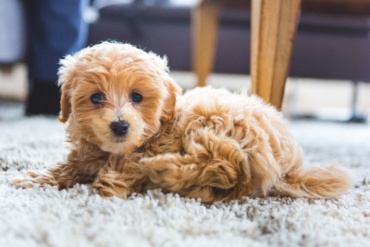Article originally published on The Spruce Pets. Written by Adrienne Kruzer. Refer to the original article here.
Just like a new kitten, puppies love to explore, but they also need to be protected while they learn about their new environments, especially for the vital first 30 days in their new homes. Puppy-proofing your home is a necessary and simple step you can take to help keep your puppy safe.
Why You Should Puppy Proof Your Home
Puppies do not know what is safe or what is dangerous, so it is up to you to teach them the difference and prevent them from being exposed to harmful things. While a puppy is still learning, it will test different items, reactions, and ways of doing things to see what happens, and sometimes these tests put the puppy in danger.
By proofing your home before your puppy arrives, you can help prevent these awful things from ever occurring and instead focus on other things with your new furry friend.
Steps to Puppy Proof Your Home
There are some key things you should do when puppy-proofing your home. Start by making a list of any obvious dangers you spy in your home. Don’t be afraid to get down on all fours and crawl around to see your home from a puppy’s point of view.
- Coffee tables, low shelves, and items on the ground in your home are all within reach of a puppy. Check these areas for decorative things that can be knocked down by a wagging tail or that are able to be chewed on. You will want to remove any items you don’t want to be chewed or that could be swallowed or broken by a puppy. This may include plants, sculptures or vases, food on pantry shelves, television remotes, tchotchkes, and more.
- Wires on the ground are at risk for being chewed on and could cause serious harm to a puppy. Oral burns and electrocution are potential risks of chewing on electrical cords. If possible, elevate these wires so that they are out of reach of your puppy, hide them behind items, such as furniture that your puppy is unable to get behind, or cover them with wire protectors from the home improvement store if the wires aren’t able to be moved.
- Make sure any trash cans that are out in the open are heavy enough so that they can’t be knocked over and have a secure lid on them. You don’t want your puppy getting into any garbage because items can cause gastrointestinal obstructions, vomiting, diarrhea, and can even be toxic to a dog.
- If you have a fence outside for your puppy, check it closely for any holes or openings that need to be fixed. Puppies are very curious and if they see an opening, they will try to wiggle through it. If you don’t have a fence, make sure your tie-out stake is secure and you have a secure collar and leash to attach to your puppy so it doesn’t run off and get hurt.
- Remove any rodent traps or insect bait stations that are on the ground and accessible to a puppy both indoors and outdoors. These items often contain toxins that can be deadly to any pet.
- If you have long window blind cords, you should tie them up so they are out of reach of your puppy. Damage to the blinds and cord may occur if your puppy decides to play with the strings but worse yet, getting tangled in the string or eating the strings can be life-threatening.
- Close doors to rooms that do not need to be open. This will make it easier for your puppy to stay out of trouble and for you to keep an eye on your puppy.
- Keep your toilet lid closed if your puppy is tall enough to get into the bowl. No one wants to get kisses from someone who has been drinking from the toilet.
- Have a variety of chew toys ready to be chewed on by your puppy. These will deter your puppy from wanting to chew on other items, such as furniture legs, while it is teething.
- Regularly sweep your floor to make sure there aren’t any random items on the ground that your puppy will try to eat.
Once your home has been puppy-proofed, you’ll be able to enjoy your time with your new puppy and be able to worry less about its safety.
